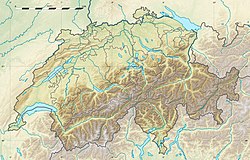利用者:加藤勝憲/グラン・サン・ベルナール・ホスピス

Lua エラー モジュール:Location_map 内、447 行目: 緯度の値が指定されていません。

グラン・サン・ベルナール・ホスピス(仏: Hospice du Grand St-Bernard、伊: Ospizio del Gran San Bernardo、独: Hospiz auf dem Grossen St. Bernhard )は、スイスのグラン・サン・ベルナール峠にある ホステル・ホスピスで、聖ベルナール・ド・モンソン に因んで名付けられ、グラン・サン・ベルナール修道院によって運営されている。 At an elevation of 2,469 m (8,100 ft) in the Pennine Alps, it is located a few hundred metres north from the border with Italy. It is part of the municipality of Bourg-Saint-Pierre in the Swiss canton of Valais.
History
[編集]最初のホスピスまたは修道院は、812年から820年頃に初めて言及されたブール・サン・ピエールに9世紀に建てられた。これは10世紀半ばにサラセン人の侵入によって破壊されたが、おそらく940年、彼らがサン・モーリスを占領したのと同じ年である。1050年頃、アオスタの首席司祭であったサン・ベルナール・ド・モンソンは、恐怖と苦悩に怯える旅人たちが定期的にやって来るのを目撃した。そこで、彼はこの地域の山賊行為を根絶することを決意した。この考えに基づき、後に自身の名を冠することになる峠のホスピスを創設した(当初は聖ニコラスに捧げられた)。この教会について最初に言及されたのは、1125年の文書である。ホスピスはシオン司教の管轄下に置かれ、司教はヴァレー州の知事および伯爵でもあった。そのため、峠全体が現在スイス領となっている理由も説明できる。
The first hospice or monastery was built in the 9th century at Bourg-Saint-Pierre, which was mentioned for the first time around 812-820. This was destroyed by Saracen incursions in the mid-10th century, probably in 940, the date at which they also occupied Saint-Maurice. Around 1050, Saint Bernard of Menthon, archdeacon of Aosta, regularly saw travellers arriving terrorised and distressed, so he decided to put an end to mountain brigandage in the area. With this in mind, he founded the hospice at the pass which later bore his name (it was originally dedicated to St Nicholas). The church's first textual mention is in a document of 1125. The hospice was placed under the jurisdiction of the bishop of Sion, prefect and count of Valais, thus explaining why the whole pass is now in Swiss territory.
St. Bernard dog
[編集]サン・ベルナール犬は、1660年代から1670年代にかけておそらくヴァリス地方の家族から寄贈された犬を交配させることで、修道院で作り出された。この犬種について初めて明確に言及されたのは1709年のことである。この犬種は、山岳救助犬となる以前は、修道院の番犬として飼育されていた。セント・バーナードは、深い雪原を越えるのに十分な強靭な体力を持ち、また、迷子になった旅行者の匂いを追跡する能力も備えていたため、山岳救助犬として特別に繁殖・訓練された。修道院でセント・バーナードが使役されていたことを示す最初の証拠は、サルバトール・ローザが1690年に描いた2枚の絵画である。
The St Bernard dog breed was created at the hospice from cross-breeding dogs, probably those offered by families in Valais in the 1660s and 1670s. The first definite mention of the breed is in 1709. The breed was originally raised to provide guard dogs for the hospice, before they became mountain rescue dogs. The St Bernards were specially bred and trained for the role of mountain rescue because they were sufficiently strong to cross deep snow drifts and had the capacity to track lost travellers by scent. The first evidence that the dogs were in use at the monastery is in two paintings dating to 1690 by Salvator Rosa.

犬は、旅人を生き返らせるために首にブランデーの小瓶を下げていると描写されることが多い。これは概して19世紀の神話であるように見えるが[2]、本当にそうした犬が少なくとも1匹はいたようだ。1823年に出版されたトマス・バイヤーリーの著書『パーシー逸話集』には、次のような逸話が掲載されており、19世紀には他の書籍でもよく引用されていた。
The dogs are often depicted as carrying a small flask of brandy around their necks to revive travellers. While this appears to have generally been a 19th-century myth, there was apparently at least one dog that really did. In The Percy Anecdotes, by Thomas Byerley, published in 1823, the following anecdote appears, and was often quoted in other books in the 19th century:
僧侶たちが飼っていた、僧侶たちの補助をする犬の品種は...、その賢さと忠誠心で昔から有名であった。最も高齢で、最も経験豊富な犬たちは最近、不幸な旅人たちとともに雪崩に埋もれてしまったが、3、4匹の子犬たちは修道院に残され、今も生き延びている。最も名高い犬はバリーと呼ばれていた。この犬は12年間病院で奉仕し、その間に40人の命を救った。その熱心さは尽きることがなかった。山が霧や雪に包まれると、彼は迷子になった旅行者の捜索に出発した。彼は息が切れるまで吠えながら走ることに慣れており、最も危険な場所にも度々進んで行った。彼が、凍えきった旅行者を雪の中から引っ張り出すのに自分の力が不十分だと感じると、彼は修道院に戻って修道士たちを捜しに行った…。
The breed of dogs kept by the monks to assist them ... has been long celebrated for its sagacity and fidelity. All the oldest and most tried of them were lately buried, along with some unfortunate travellers, under a valanche [sic]; but three or four hopeful puppies were left at home in the convent, and still survive. The most celebrated of those who are no more, was a dog called Barry. This animal served the hospital for the space of twelve years, during which time he saved the lives of forty individuals. His zeal was indefatigable. Whenever the mountain was enveloped in fogs and snow, he set out in search of lost travellers. He was accustomed to run barking until he lost breath, and would frequently venture on the most perilous places. When he found his strength was insufficient to draw from the snow a traveller benumbed with cold, he would run back to the hospital in search of the monks….
老齢により体力が衰えると、修道院長は彼に年金を支給した。彼の死後、彼の皮は剥がされ、その町の博物館に保管された。山中で遭難した旅人のために彼が携行していた、命を救う酒を入れた小さな小瓶は、今でも彼の首から下げられている。[3]
When old age deprived him of strength, the Prior of the Convent pensioned him at Berney, by way of reward. After his death, his hide was stuffed and deposited in the museum of that town. The little phial, in which he carried a reviving liquor for the distressed travellers whom he found among the mountains, is still suspended from his neck.[1]
最後に犬が救助を行った記録は1955年のものであるが、2004年には、感情や伝統を理由に、18頭の犬がまだホスピスで飼育されていた。2004年には、マルティニーのバリー財団が犬の繁殖を引き受け、残りのセント・バーナードはそこからホスピスに移された。セント・バーナードは現在も観光名所であり、夏の間はマルティニーからホスピスに一時的に移動する犬もいる。
The last recorded rescue by one of the dogs was in 1955, although as late as 2004 eighteen of the animals were still kept at the Hospice for reasons of sentiment and tradition. In 2004, the breeding of the dogs was undertaken by the Barry foundation at Martigny, and the remaining St Bernards were transferred there from the Hospice. They remain a tourist attraction, and a number of the animals are temporarily relocated from Martigny to the Hospice during the summer months.
Memorial
[編集]1800年6月、ナポレオン・ボナパルトは、予備軍とともにアルプスを越えていなかったにもかかわらず、ルイ・デジー(マレンゴの戦いで戦死)のために、ホスピスに記念碑的な墓を建設するよう命じた。彼の遺体は1800年から1805年までミラノに安置され、その後、皇帝の代理であるルイ・アレクサンドル・ベルティエの立ち会いのもと、ホスピスに埋葬された。礼拝堂に建てられた記念碑は1829年に移動され、現在、デセは聖ファウスティナに捧げられた祭壇の下に匿名で眠っている。
In June 1800, Napoleon Bonaparte ordered a monumental tomb to be built at the Hospice for Louis Desaix (killed at the Battle of Marengo), even though Desaix had not crossed the Alps with the armée de réserve. His body rested at Milan from 1800 to 1805, when it was buried at the hospice in the presence of Louis-Alexandre Berthier representing the emperor. A commemorative monument set up there in a chapel was moved in 1829, so that Desaix now lies anonymous under an altar dedicated to Saint Faustina.
In popular culture
[編集]修道院は、1857年に発表されたチャールズ・ディケンズの小説『リトル・ドリティット』の1章の舞台となっている。その章では、寒さに凍えた旅人と彼らのラバが一夜を過ごし、安置所で凍死した身元不明の死体と比較されている。修道僧たちが管理する犬や周辺の避難所についても言及されている。ディケンズは1846年にこの場所を訪れ、霊安室も見ており、1846年9月6日付で友人であり伝記作家でもあるジョン・フォスターに宛てた手紙にその様子を記している。スウェーデンの作家で改革者でもあったフレードリカ・ブレーマーもホスピスを訪れ、その体験を著書『旧世界での生活』(英語訳はメアリー・ハウイット著、1860年)の第1巻に記している。
The monastery is the setting for one chapter in the 1857 Charles Dickens novel Little Dorrit, wherein some cold travellers and their mules spend the night, and are compared to some frozen unidentified dead bodies in the mortuary, which had been recovered from the mountain by the Fathers. The dogs and some outlying refuge shelters maintained by the monks are also mentioned. Dickens visited the place and saw the mortuary in 1846, and described it in a letter to his friend and biographer John Forster dated 6 September 1846. The Swedish writer and reformer Fredrika Bremer also visited the Hospice, and recorded her experience in vol. 1 of Life in the Old World (English trans. by Mary Howitt, 1860).
脚注
[編集]- ^ Byerley, Thomas (1823). The Percy Anecdotes (1826 ed.). London: T. Boys. pp. 25–26 15 April 2018閲覧。
Sources
[編集]- Jean-Luc Rouiller, Le Valais par les dates : une chronologie des origines à nos jours, dans Annales valaisannes, 1999, p. 105, 106, 109.
- Le Grand-Saint-Bernard (collectif), dans Les chanoines réguliers de Saint-Augustin en Valais, Bâle, 1997 (Helvetia sacra, IV/1)
- Lucien Quaglia, La maison du Grand-Saint-Bernard des origines aux temps actuels, Martigny, 1972.
外部リンク
[編集]座標: 北緯45度52分08秒 東経7度10分14秒 / 北緯45.86889度 東経7.17056度座標: 北緯45度52分08秒 東経7度10分14秒 / 北緯45.86889度 東経7.17056度{{#coordinates:}}: 各ページで primary のタグは複数指定できません [[Category:ヴァレー州の建築物]]

